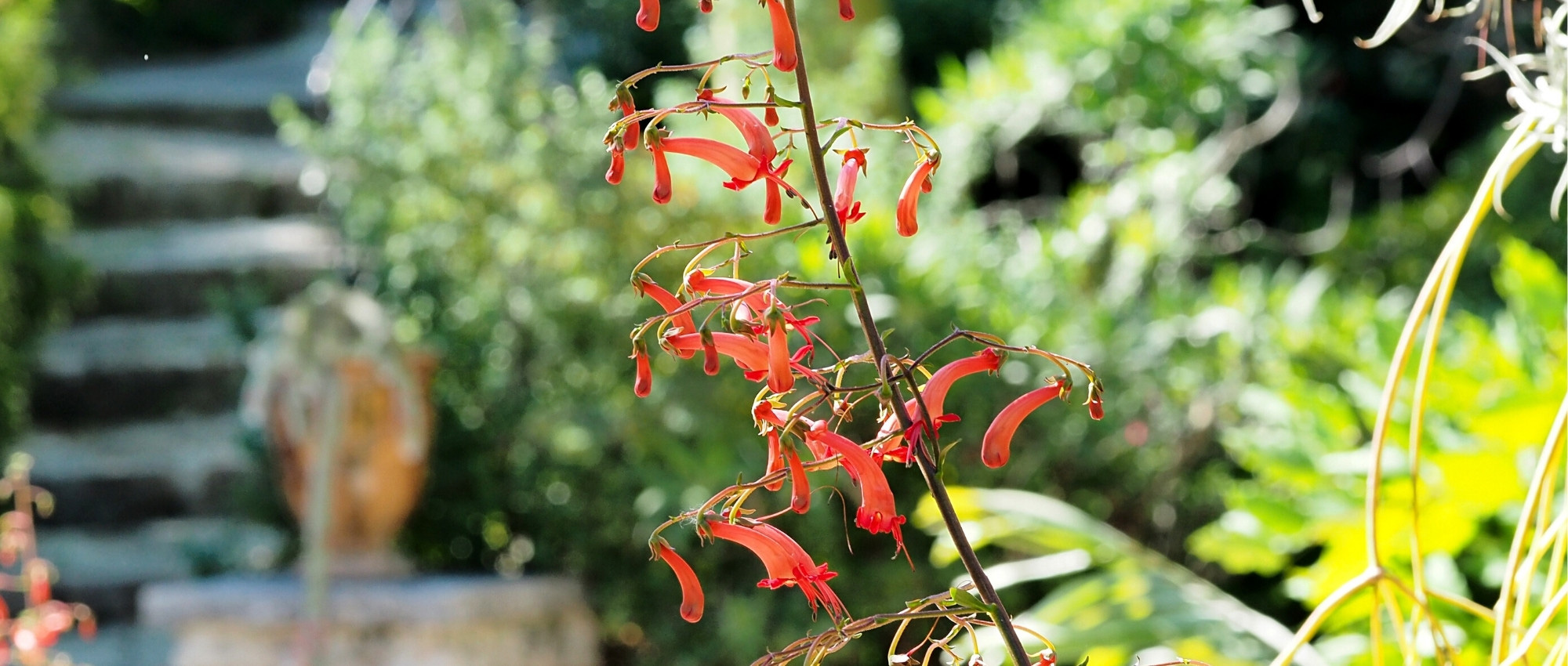
Phygelius: Plant, cultivate and maintain
Contents
Phygelius in a nutshell
- Phygelius is a South African perennial that offers a generous summer flowering
- Its very light flowering is appreciated, in airy panicles made up of numerous small tubular flowers
- It is available in a palette of bright colours: pink, red, orange, or yellow
- It is ideal for mixed borders, in an exotic bed, or in a pot on the terrace!
A word from our expert
Phygelius, or Cape Fuchsia, is a beautiful South African perennial that produces panicles of numerous small tubular flowers in summer. There are many varieties offering red, coral pink, or pale yellow flowers. Its foliage is semi-evergreen. Phygelius are sucker-forming plants: when conditions are favourable, they produce underground runners that allow the clump to expand, without becoming invasive.
Phygelius thrives in full sun, or in partial shade in the southern regions of France, particularly in the Mediterranean basin. It prefers fertile, clayey, and cool, yet well-drained soils. Although it is native to South Africa, it can withstand temperatures as low as -10 °C. In cooler regions, it is possible to grow it in a pot so that it can be brought indoors for the winter. Discover all our tips for successfully cultivating it in the garden in this guide.
Botany
Botanical data
- Latin name Phygelius sp.
- Family Scrophulariaceae
- Common name Cape Fuchsia, Cape Scrophularia
- Flowering between June and September-October
- Height between 60 cm and 1.5 m
- Sun exposure full sun or partial shade
- Soil type fertile, clayey and cool, well-draining
- Hardiness -10 to -12 °C
Phygelius, commonly known as Cape Fuchsia, is a perennial native to South Africa, where it grows on moist slopes, by watercourses and in forests, mainly in mountainous regions. Phygelius consists of only two species: Phygelius aequalis and Phygelius capensis. The latter is the hardiest, as it can withstand temperatures down to -12 °C, and even -15 °C in well-drained soil and a sheltered position. There are also many varieties resulting from cross-breeding between these two species. The hybrids are known as Phygelius x rectus.
Phygelius capensis and Phygelius aequalis are very similar, however, the former has slightly shorter and wider flowers, which are arranged all around the stems, while those of Phygelius aequalis are all positioned on the same side. In South Africa, Phygelius capensis grows at higher altitudes (up to 3000 meters), which explains its better hardiness.
Phygelius belongs to the family Scrophulariaceae, like Buddleia, Diascia, Nemesia, and Verbascum. Despite its nickname of Cape Fuchsia, Phygelius does not belong to the same family as true Fuchsia, which is an Onagraceae.
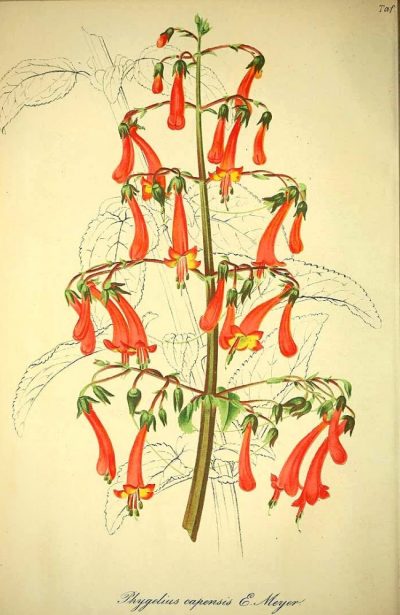
Phygelius capensis: Botanical illustration
Etymologically, the name Phygelius comes from the Greek Phyge: “refuge, shelter” and Helios: “sun”, as in South Africa it thrives in shaded environments. However, in our climates, it is better to plant it in full sun. The species name capensis refers to its geographical origin, the Cape region in South Africa. The species name of Phygelius aequalis means “equal, of similar size”.
Phygelius has a bushy habit, reaching between 60 cm and 1.5 m in height. When the growing conditions are suitable, Phygelius produces underground stolons, allowing the original stump to gradually expand, but they do not become invasive.
Phygelius flowers in summer, typically between June and August, sometimes until frost. Above the foliage, large, airy panicles measuring 15 to 30 cm in length unfold. The flowering is generous, with a multitude of small tubular flowers, long and slender, consisting of five fused petals. The flowers measure 2 to 6 cm long and are inclined towards the ground. Depending on the varieties, the flowers are red, coral pink, orange, or pale yellow. Some varieties, such as ‘African Queen’, are beautifully coloured at the tip of the corolla tube. It is interesting to place them at a height to admire this coloration. The four stamens (male reproductive organs, bearing pollen) and the pistil (female reproductive organ, receiving pollen) protrude from the corolla tube. The stems bearing the flowers sometimes take on a lovely reddish-purple hue. The flowering of Phygelius resembles that of fuchsia or penstemon, with a longer and finer floral tube.
The corolla tubes contain nectar that attracts pollinators, allowing Phygelius to reproduce. In South Africa, it is pollinated by birds as well as butterflies and bees.

The flowering of Phygelius ‘Yellow Trumpet’, Phygelius ‘Jodie Southon’ (photo peganum), Phygelius capensis (photo Adobe Stock) and Phygelius ‘Funfare Wine’
The foliage of Phygelius is semi-evergreen. It persists if the winter is not too cold, and disappears when temperatures drop below -7 °C. New leaves will appear in spring.
Phygelius bears simple, ovate to lanceolate, dark green leaves. They measure between 6 and 10 cm long. They are arranged in opposite pairs on the stems (two leaves inserted at the same level, facing each other), but sometimes alternately for the leaves located at the top of the stems. There is a variety with chartreuse foliage, almost yellow: Phygelius ‘Sunshine’. It is appreciated for its incredibly bright foliage.
The fruit of Phygelius is an ovoid capsule, which opens at maturity by two valves to release the brown seeds it contains. It is possible to multiply Phygelius by sowing, but also by propagation by cuttings or division.

The foliage of Phygelius (photos: Franz Xaver / Stan Shebs / Wouter Hagens)
The main varieties of Phygelius
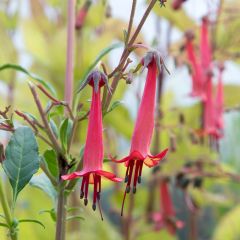
Phygelius African Queen - Cape Fuchsia
- Flowering time July to September
- Height at maturity 90 cm
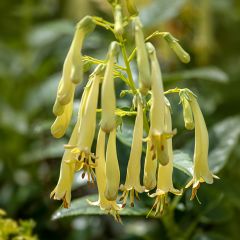
Phygelius Moonraker - Cape Fuchsia
- Flowering time July to September
- Height at maturity 90 cm

Phygelius Blacher - Cape Fuchsia
- Flowering time July to September
- Height at maturity 75 cm
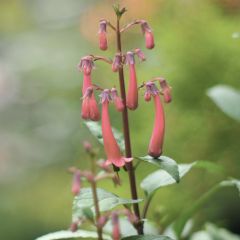
Phygelius aequalis Pink Trumpet - Cape Fuchsia
- Flowering time August to November
- Height at maturity 1,50 m
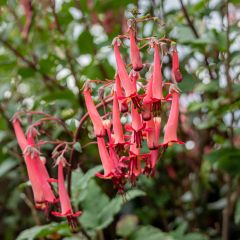
Phygelius capensis - Cape Fuchsia
- Flowering time July to November
- Height at maturity 1 m
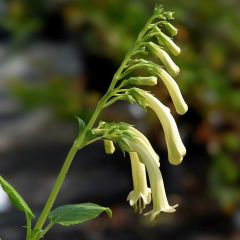
Phygelius aequalis Yellow Trumpet - Cape Fuchsia
- Flowering time August to November
- Height at maturity 1,50 m
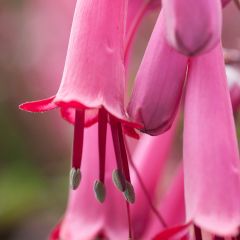
Phygelius Funfare Wine - Cape Fuchsia
- Flowering time July to October
- Height at maturity 50 cm

Phygelius aequalis Croftway Yellow Sovereign - Cape Fuchsia
- Flowering time July to November
- Height at maturity 60 cm
Discover other Phygelius
View all →Available in 1 sizes
Available in 1 sizes
Available in 1 sizes
Available in 1 sizes
Available in 1 sizes
Available in 1 sizes
Available in 1 sizes
Available in 1 sizes
Young plantation
Where to plant Phygelius?
Native to South Africa, Phygelius enjoys sun and warmth. In the south of France, for example in the Mediterranean basin, where sunlight is abundant, you can easily plant in partial shade, whereas in other regions, it is better to plant Phygelius in full sun. If it lacks sunlight, it tends to produce longer and weaker shoots. Compared to Phygelius capensis, the species Phygelius aequalis tolerates shadier conditions better.
Phygelius prefers fertile, clayey, and cool but well-drained soils as it does not like stagnant moisture in winter. It is indifferent to pH: it grows well in acidic, neutral, or calcareous soils. Be cautious if you live by the sea, Phygelius does not like sea spray. In cooler regions, choose a location sheltered from cold winds.
You can also plant Phygelius in a large pot, which you can place at a height, for example on a wall, a windowsill, or suspended. This highlights it as its flowers are trailing and the throat of some varieties is coloured (like in Phygelius ‘African Queen’), which can only be seen from below.
When to plant?
The best time to plant Phygelius is spring, around April.
How to plant?
For a more beautiful effect, do not hesitate to plant several young plants together, keeping at least 50 or 60 cm apart.
In the ground:
- Dig a large planting hole and loosen the soil deeply.
- Add a mixture of potting soil and garden soil to the bottom of the hole.
- Plant the Phygelius.
- Replace with a mixture of potting soil and soil to fill the hole.
- Lightly firm the soil around the root ball.
- Water generously.
- You can then add a layer of mulch around the stump.
In a pot:
- Choose a large pot (with drainage holes at the bottom).
- Place a drainage layer, for example made of clay balls, gravel, or broken pot pieces.
- Then add potting soil to the pot.
- Plant the Phygelius, well in the centre of the pot.
- Replace with potting soil all around.
- Lightly firm the soil.
- Water.
You can then place the pot in a sunny spot, for example on a terrace.
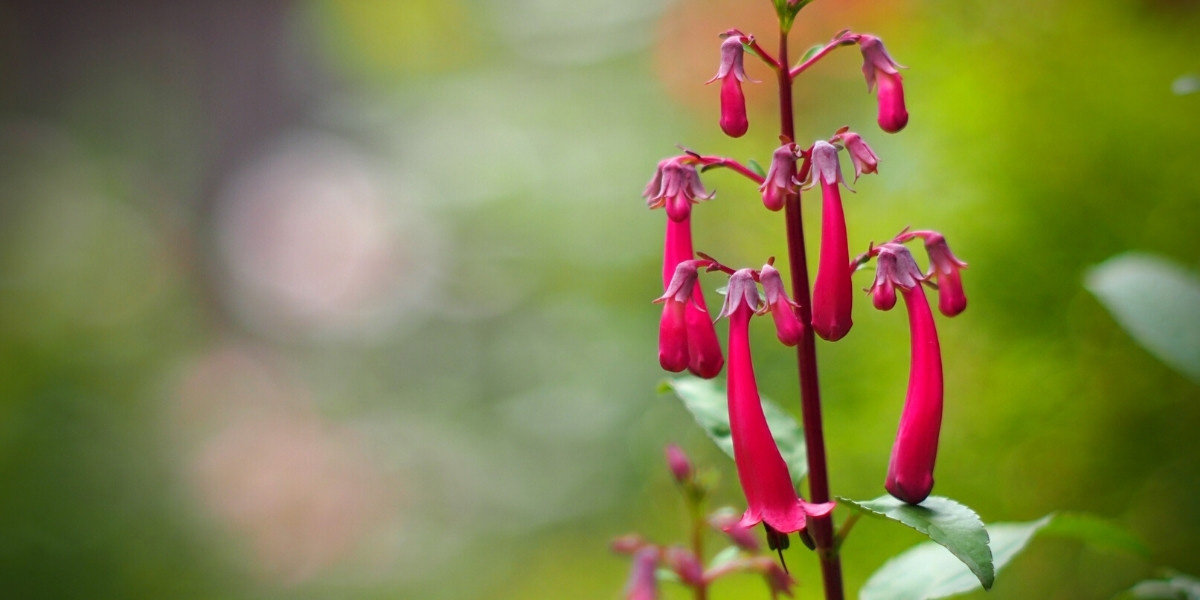
Phygelius aequalis ‘New Scentsation’ (photo: M’s photography)
Maintenance
In South Africa, Phygelius generally grows in moist soils or along the banks of watercourses: it therefore appreciates soils that remain relatively cool. We recommend regular watering, especially during summer. This will ensure a long and generous flowering. Be cautious with watering if you are growing Phygelius in a pot, as the substrate tends to dry out more quickly than in open ground. Do not hesitate to install a layer of organic mulch to keep the soil cool for longer. Additionally, this will protect the stump from cold during frost while limiting the growth of weeds.
In a mild climate, where the risk of frost is low (for example, the Mediterranean basin or the Atlantic coast), it is not necessary to protect it in winter. In cooler regions, apply a thick layer of mulch around the clump in autumn. If you are growing it in a pot, we recommend bringing it under shelter to keep it frost-free.
Phygelius produces long, flexible stems and large panicles that sometimes tend to droop. You can install discreet supports to keep them upright. We also recommend removing the inflorescences when they are faded as this will encourage Phygelius to produce new ones, thus prolonging its flowering. At the end of winter or the beginning of spring, around March, prune back to cut the stems almost to ground level.
In a mild climate and when conditions suit it, Phygelius tends to produce suckers. This allows the clumps to gradually expand, but it does not become invasive.
Phygelius is not very susceptible to diseases and pests. However, it can be attacked by Cionus scrophulariae, a small beetle that usually feeds on scrophulariaceae.
Multiplication
Sowing
Phygelius seeds are sown in spring.
- Prepare pots or a seed tray by placing special seed compost, or a mixture of compost and sand.
- Lightly firm down and level the surface.
- Place the seeds on the surface.
- Then cover them with a thin layer of compost.
- All that’s left to do is water gently and place the pots in a sheltered location.
The seeds germinate in two weeks when kept at a temperature of 20 °C to 25 °C. If the temperature is lower, germination will take a bit longer. You can transplant the young plants outdoors after the last frosts.
Propagation by Cuttings
It is possible to propagate Phygelius by cuttings in spring, around May, or in mid-summer.
- Choose a healthy stem and cut it just below a node to obtain a section 10 to 15 cm long.
- Remove the leaves from the base, leaving only a few at the top of the stem.
- Prepare a pot with compost.
- Optionally dip the base of the stem in plant hormone.
- Plant it in the compost, and firm it well all around to ensure good contact between the medium and the stem, avoiding air pockets.
- Water.
- Place the cutting in a sheltered location, in a bright spot but out of direct sunlight, ideally at a temperature of around 20 °C.
Then ensure that the medium remains slightly moist. The cuttings take about 3 weeks to root.
Division of Clumps
As Phygelius are sucker-forming plants, they produce underground runners, making it possible to take suckers to multiply the plant. The best time to do this is in March-April.
- Choose a healthy, well-developed clump.
- Use a spade to dig it up, digging wide enough not to damage the roots.
- Separate it into several sections, ensuring that each retains roots.
- Replant in a new location or in a pot.
- Water generously.
Association
Phygelius is ideal for mixed borders, among other perennials with colourful flowering. You can create a bohemian-style garden, with flowers in warm hues and a light, airy style. Consider red valerian, gaillardias, Anthemis, and Achilleas. Penstemons will also be excellent companions for phygelius: the shape of their flowering, in panicles made up of small tubular flowers, will resemble that of phygelius. The colourful blooms of dahlias will also fit beautifully into this style of border: those with very double flowers (for example, ball and cactus dahlias) will bring a refined effect, while those with single flowers will enhance the naturalistic and rustic atmosphere. Don’t hesitate to plant some clumps of grasses among them, such as Stipa tenuifolia: its fine foliage and light spikes will undulate beautifully in the wind. Still in warm tones, add height with climbing plants, such as trumpet vine, and shrubs: we particularly recommend Lagerstroemia or Crepe Myrtle.
Discover our advice sheet “Creating a Bohemian Garden”
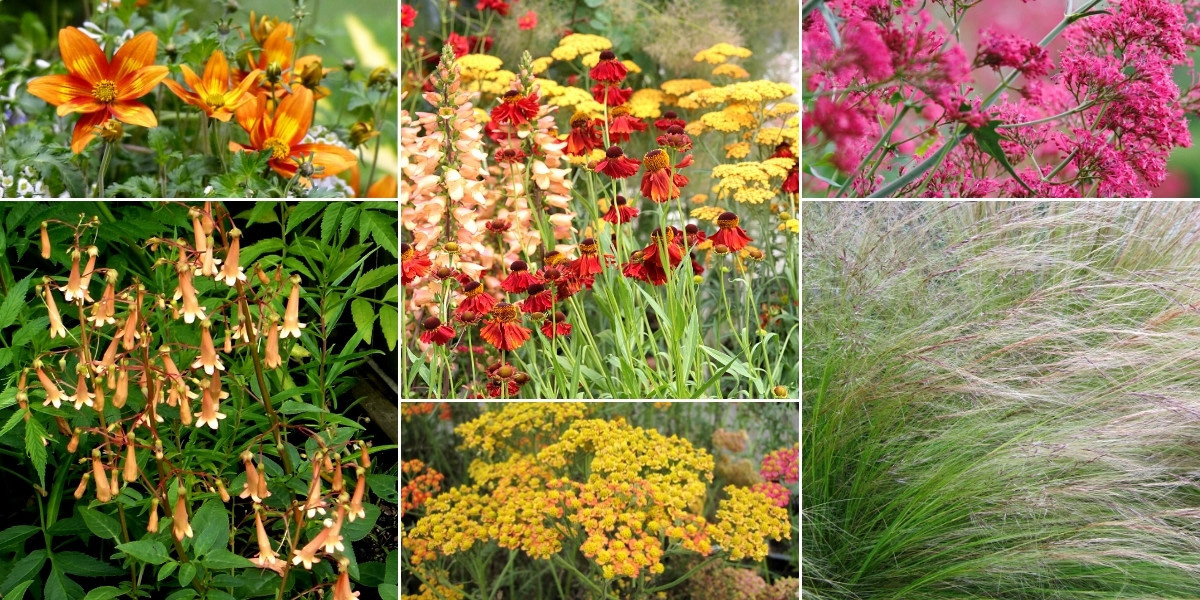
Bidens ‘Campfire Funny Honey’, Helenium ‘Morheim Beauty’, Digiplexis ‘Illumination Chelsea Gold’ and Achillea ‘Terracotta’, Centranthus ruber, Phygelius ‘Jodie Southon’ (photo peganum), Achillea millefolium ‘Feuerland’ and Stipa tenuifolia (photo Leonora Enking)
Native to South Africa, Phygelius will easily find its place in an exotic-style garden. You can plant it alongside other South African plants. Consider, for example, Berkheya purpurea, an original perennial resembling a thistle and bearing very beautiful white flowers with a dark purple centre. But the queen of this southern border will undoubtedly be the Protea cynaroides, emblem of South Africa, which offers impressive flowers crowned with large radiant bracts, pink, red, or orange. Also discover Dierama, a splendid South African perennial, poetically nicknamed Angel’s Fishing Rod, which bears very beautiful bell-shaped flowers in pink, orange, or white at the end of its long trailing stems. You can integrate crocosmias, kniphofias, eucomis, and agapanthus alongside it. For ground cover, consider Delosperma ‘Wheels of Wonder Fire’, a small spreading perennial that offers very beautiful flowers in bright orange heads, which stand out wonderfully against its succulent foliage.
For more pairing ideas, feel free to check our inspiration page “Australian Exoticism”

Protea ‘Pink Crown’ (photo V. Manso), Phygelius capensis, Berkheya purpurea, Eucomis ‘Sparkling Rosy’, Delosperma ‘Wheels of Wonder Fire’ and Dierama igneum (photo peganum)
- Subscribe!
- Contents































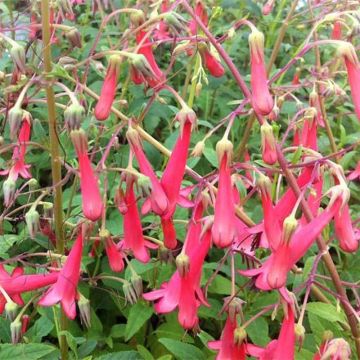





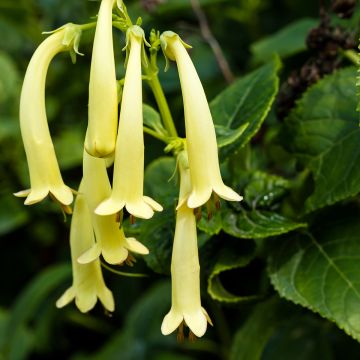

Comments